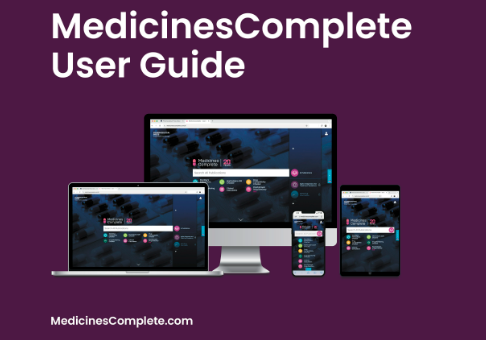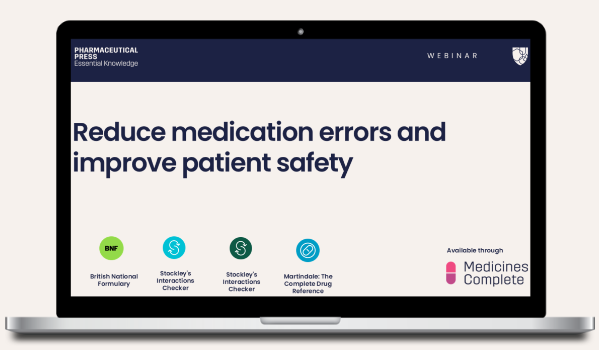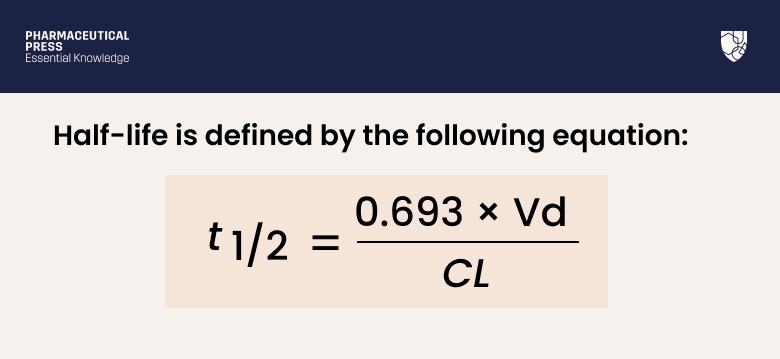What is the half-life of a drug?
Half-life refers to the time it takes for the concentration of a drug in the body to decrease to half of its original amount after administration.¹ ²
It helps health professionals to determine appropriate dosing intervals, estimate the time needed to reach steady-state levels, and understand how long a drug will remain in the body.
In this article, we will explain what a half-life is and its role in the pharmacokinetics of a drug. We will also look at the importance of the concept in mental health medications, and where to find information on the half-lives of individual drugs.
Please complete the form at the bottom of this article to request a complimentary trial of MedicinesComplete.
What does half-life mean in medical science?
The half-life (t½) of a drug is the time it takes for the concentration of a drug in the body to decrease by 50%. After one half-life has passed, half of the initial drug amount has been eliminated from the body. Each individual drug has a different half-life (t½).¹
Half-life is a key pharmacokinetic parameter. Pharmacokinetics is the study of how a drug moves through body – how it is absorbed, distributed, metabolised, and excreted (ADME).²
While all ADME processes influence a drug’s half-life, distribution and excretion are the most relevant. Distribution determines how quickly and how much of the drug reaches its target site of action.¹
It is influenced by factors such as body mass, tissue blood flow, and protein binding. The volume of distribution (Vd) reflects the extent of drug distribution and varies with age, body weight, illness, and fluid shifts. Excretion refers to how and where a drug, or its metabolites, is eliminated from the body. Clearance (Cl) is the measure for how efficiently a drug is excreted. Renal or liver impairment, age-related changes, co-morbidities, and drug interactions can all alter clearance and impact half-life.²
Half-life is defined by the equation t½=(0.693 x Vd)/Cl.
It is directly proportional to the volume of distribution, and inversely proportional to clearance.²
Why is the half-life of a drug important?
Half-life impacts the time it takes for a drug to reach steady-state levels. Assuming the dose of administered drug is greater than the dose eliminated during the dosing interval, it will take about five half-lives to reach steady-state levels.³
Understanding the half-life of a drug is important for a number of reasons. It helps determine how often a drug should be taken and how long it takes for a drug to reach steady-state levels – typically five half-lives assuming consistent dosing and elimination.⁴
It also helps to predict how long it will take for a drug to completely leave the body after discontinuation.¹ ² ³
Drugs with short half-lives leave the body quickly, and patients may need to take them more frequently. They are also more likely to be associated with withdrawal or discontinuation syndromes.³
Drugs with long half-lives stay in the body longer, and have a longer duration of action allowing for less frequent dosing – but increasing the risk of accumulation and toxicity if not managed carefully.³
Why is the half-life of mental health medications important?
In mental health, patients often switch medicines and adjust treatment regimens.
Psychotropic medications with short half-lives, and therefore rapid washout periods, have been associated with withdrawal symptoms and drug discontinuation syndromes.³
Short-acting benzodiazepines, such as alprazolam and lorazepam, for example, are more problematic to discontinue than long-acting benzodiazepines, such as diazepam and clonazepam.³
Psychotropic medications with long half-lives—such as fluoxetine or aripiprazole, require careful management due to their prolonged duration in the body. While they require less frequent dosing, they can also delay the onset therapeutic effects and side effects, complicate switching between medications, and increase the risk of drug accumulation and interactions.
Where can you find information about the half-life of a drug?
Health professionals can find information on the half-life of individual drugs in the pharmacokinetics section of Martindale: The Complete Drug Reference or in the Summary of Product Characteristics found on the Electronic Medicines Compendium (emc), available through MedicinesComplete.
Specialist resources such as Critical Illness and Psychotropic Drug Directory have information on pharmacokinetic parameters such as half-life to guide dosing in these care settings.
Trial form
Please complete the form below to request a complimentary trial to knowledge products through MedicinesComplete.
References
1. Hallare, J., Gerriets, V. (2023). Half-life. In StatPearls [Internet]. StatPearls Publishing.
2. Grogan, S., Preuss, C. V. (2023). Pharmacokinetics. In StatPearls [Internet]. StatPearls Publishing.
3. Andrade, C. (2022). The practical importance of half-life in psychopharmacology. The Journal of Clinical Psychiatry, 83(4), 41940.
4. Andrade, C. (2022). The practical importance of half-life in psychopharmacology. The Journal of Clinical Psychiatry, 83(4), 41940.









